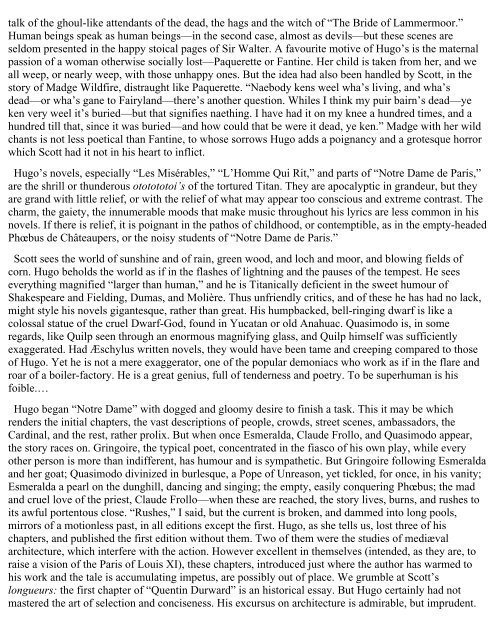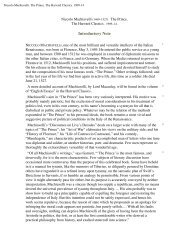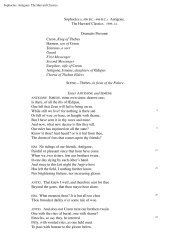Notre Dame de Paris - Bartleby.com
Notre Dame de Paris - Bartleby.com
Notre Dame de Paris - Bartleby.com
Create successful ePaper yourself
Turn your PDF publications into a flip-book with our unique Google optimized e-Paper software.
talk of the ghoul-like attendants of the <strong>de</strong>ad, the hags and the witch of “The Bri<strong>de</strong> of Lammermoor.”<br />
Human beings speak as human beings—in the second case, almost as <strong>de</strong>vils—but these scenes are<br />
seldom presented in the happy stoical pages of Sir Walter. A favourite motive of Hugo’s is the maternal<br />
passion of a woman otherwise socially lost—Paquerette or Fantine. Her child is taken from her, and we<br />
all weep, or nearly weep, with those unhappy ones. But the i<strong>de</strong>a had also been handled by Scott, in the<br />
story of Madge Wildfire, distraught like Paquerette. “Naebody kens weel wha’s living, and wha’s<br />
<strong>de</strong>ad—or wha’s gane to Fairyland—there’s another question. Whiles I think my puir bairn’s <strong>de</strong>ad—ye<br />
ken very weel it’s buried—but that signifies naething. I have had it on my knee a hundred times, and a<br />
hundred till that, since it was buried—and how could that be were it <strong>de</strong>ad, ye ken.” Madge with her wild<br />
chants is not less poetical than Fantine, to whose sorrows Hugo adds a poignancy and a grotesque horror<br />
which Scott had it not in his heart to inflict.<br />
Hugo’s novels, especially “Les Misérables,” “L’Homme Qui Rit,” and parts of “<strong>Notre</strong> <strong>Dame</strong> <strong>de</strong> <strong>Paris</strong>,”<br />
are the shrill or thun<strong>de</strong>rous ototototoi’s of the tortured Titan. They are apocalyptic in gran<strong>de</strong>ur, but they<br />
are grand with little relief, or with the relief of what may appear too conscious and extreme contrast. The<br />
charm, the gaiety, the innumerable moods that make music throughout his lyrics are less <strong>com</strong>mon in his<br />
novels. If there is relief, it is poignant in the pathos of childhood, or contemptible, as in the empty-hea<strong>de</strong>d<br />
Phœbus <strong>de</strong> Châteaupers, or the noisy stu<strong>de</strong>nts of “<strong>Notre</strong> <strong>Dame</strong> <strong>de</strong> <strong>Paris</strong>.”<br />
Scott sees the world of sunshine and of rain, green wood, and loch and moor, and blowing fields of<br />
corn. Hugo beholds the world as if in the flashes of lightning and the pauses of the tempest. He sees<br />
everything magnified “larger than human,” and he is Titanically <strong>de</strong>ficient in the sweet humour of<br />
Shakespeare and Fielding, Dumas, and Molière. Thus unfriendly critics, and of these he has had no lack,<br />
might style his novels gigantesque, rather than great. His humpbacked, bell-ringing dwarf is like a<br />
colossal statue of the cruel Dwarf-God, found in Yucatan or old Anahuac. Quasimodo is, in some<br />
regards, like Quilp seen through an enormous magnifying glass, and Quilp himself was sufficiently<br />
exaggerated. Had Æschylus written novels, they would have been tame and creeping <strong>com</strong>pared to those<br />
of Hugo. Yet he is not a mere exaggerator, one of the popular <strong>de</strong>moniacs who work as if in the flare and<br />
roar of a boiler-factory. He is a great genius, full of ten<strong>de</strong>rness and poetry. To be superhuman is his<br />
foible.…<br />
Hugo began “<strong>Notre</strong> <strong>Dame</strong>” with dogged and gloomy <strong>de</strong>sire to finish a task. This it may be which<br />
ren<strong>de</strong>rs the initial chapters, the vast <strong>de</strong>scriptions of people, crowds, street scenes, ambassadors, the<br />
Cardinal, and the rest, rather prolix. But when once Esmeralda, Clau<strong>de</strong> Frollo, and Quasimodo appear,<br />
the story races on. Gringoire, the typical poet, concentrated in the fiasco of his own play, while every<br />
other person is more than indifferent, has humour and is sympathetic. But Gringoire following Esmeralda<br />
and her goat; Quasimodo divinized in burlesque, a Pope of Unreason, yet tickled, for once, in his vanity;<br />
Esmeralda a pearl on the dunghill, dancing and singing; the empty, easily conquering Phœbus; the mad<br />
and cruel love of the priest, Clau<strong>de</strong> Frollo—when these are reached, the story lives, burns, and rushes to<br />
its awful portentous close. “Rushes,” I said, but the current is broken, and dammed into long pools,<br />
mirrors of a motionless past, in all editions except the first. Hugo, as she tells us, lost three of his<br />
chapters, and published the first edition without them. Two of them were the studies of mediæval<br />
architecture, which interfere with the action. However excellent in themselves (inten<strong>de</strong>d, as they are, to<br />
raise a vision of the <strong>Paris</strong> of Louis XI), these chapters, introduced just where the author has warmed to<br />
his work and the tale is accumulating impetus, are possibly out of place. We grumble at Scott’s<br />
longueurs: the first chapter of “Quentin Durward” is an historical essay. But Hugo certainly had not<br />
mastered the art of selection and conciseness. His excursus on architecture is admirable, but impru<strong>de</strong>nt.










